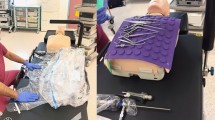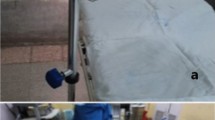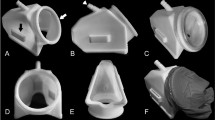Abstract
Within Neurotology, special draping systems have been devised for mastoid surgery recognizing that drilling of middle ear mucosa is an aerosol generating medical procedure (AGMP) which can place surgical teams at risk of COVID-19 infection. We provide a thorough description of a barrier system utilized in our practice, along with work completed by our group to better quantify its effectiveness. Utilization of a barrier system can provide near complete bone dust and droplet containment within the surgical field and prevent contamination of other healthcare workers. As this is an early system, further adaptations and national collaborations are required to ultimately arrive at a system that seamlessly integrates into the surgical suite. While these barrier systems are new, they are timely as we face a pandemic, and can play a crucial role in safely resuming surgery.
Similar content being viewed by others
Introduction
A major challenge in the provision of care during the COVID-19 pandemic is to secure personal protective equipment (PPE) while working to curb the spread of this novel coronavirus. As hospitals prepare to resume surgical activities, the concern for false negative screening tests combined with shortages of N95 masks have highlighted the need for additional safeguards when performing potentially aerosol generating medical procedures (AGMPs) [1]. In the case of otologic surgeries, the middle ear has demonstrated concomitant viral colonization from the nasopharynx [2,3,4] raising concerns for dispersion due to the need for prolonged drilling, irrigation and suctioning. The aerosolized bone dust and large amounts of droplets may infect healthcare providers [2,3,4,5].
Use of an operative barrier system for AGMPs
Simple barrier draping systems have been described with some published experiences. However, restricted mobility, adaptability, and additional equipment purchases or customizations have limited widespread adoption [6, 7]. We sought to improve upon prior designs by utilizing readily available operative equipment to suspend a barrier drape over the surgical field, to promote superior surgical ergonomics and droplet containment, while preserving operative visibility (Additional file 1). This system is now being utilized for urgent neurotology surgeries in our practice in addition to other protective practices such as pre-operative COVID-19 testing 48 h before surgery when feasible. Individual personal protective equipment for the surgical team includes gown, gloves, and surgical mask, with the addition of face shield when not working under the microscope. The circulating nurse and anesthetist utilize a surgical mask at all times, adding N95 mask, gown, gloves and face shield when intubating and extubating. As we move forward to facilitate elective surgeries, we believe the barrier system outlined will play an important role in the provision of safe surgical management.
What is the evidence so far?
Current evidence to support the use of barrier systems in AGMPs involve quantification of droplet dispersion in simulated settings. The barrier system proposed has been assessed by our group through the simulation of a mastoidectomy in the operative theatre. In addition to the inclusion of a surgeon and assistant, a manikin was created to simulate a scrub nurse. A polymer-based 3D printed temporal bone was bolstered into a simulated patients’ Styrofoam head for drilling. Surgical irrigation containing fluorescein dye (1 mg/mL) was used to visualize droplet contamination.
Two mastoidectomies were performed under standard draping protocol, one with and one without the barrier system. Following 15 min of drilling with a 6 mm cutting burr at speeds up to 70,000 RPM, the surgical site was examined under UV light. The droplet dispersion characteristics were compared between the two protocols.
The barrier system provided near complete bone dust and droplet containment within the surgical field (Fig. 1). Without it, dispersion was found up to 68 in. away from the ear, with frank contamination of the facemask, shield, exposed skin, and gown seen on the operative team (see Temporal Bone Drilling Video and Additional file 2). No contamination was found on any part of the team members except for the gloved hands of the surgeon and assistant using the barrier system. The participants noted no visualization interference and minimal ergonomic limitations.
In addition to simulated experience, the authors have found the system easy to incorporate in the urgent neurotology cases performed to date.
What are the harms?
Droplet containment appears to be superior with a barrier system for mastoidectomy, however care must still be taken when passing instruments and removing the drape following a procedure. Incorporating a Mayo stand within the enclosure with frequently used instruments can reduce the amount of barrier breaches required to pass instruments. Slow removal of the drape after cessation of drilling and tying the redundant drape material to the microscope can help prevent aerosolization that may result from manipulation.
While it may be reasonably inferred that droplet protection will also help minimize aerosolization, this has not been directly studied, and would not have been accurately captured in our described experience. Continuing to follow evolving guidance documents, literature on transmission risk, along with infectious disease best practices such as hand hygiene and proper doffing of surgical masks and gowns should still be advised [8, 9].
What can we expect in the future?
This novel design concept could potentially be applied to high risk AGMP procedures in other anatomical regions in the head & neck system and would be suitable for microscopic and endoscopic platforms with some modifications. As this is an early system, further adaptations and national collaborations are required to ultimately arrive at a system that seamlessly integrates into the surgical suite. Working to develop more effective and efficient means of pre-operative COVID-19 testing, as well as other perioperative prevention strategies will continue to play an important role of an overall preventative strategy. As we struggle to deal with the backlog of semi-urgent and elective procedures from COVID-19 restrictions, prioritizing research advances in barrier devices can assist in the safe return of patients, health professionals, and learners to the operating rooms in Canada.
Additional file 3: Video 2. Drape Placement Tutorial. Additional visualization of drape assembly.
Availability of data and materials
The datasets used and/or analysed during the current study are available from the corresponding author on reasonable request.
Abbreviations
- PPE:
-
Personal protective equipment
- AGMP:
-
Aerosol generating medical procedures
References
Li W, Huang J, Guo X, Zhao J, Mandell S. Anesthesia management and perioperative infection control in patients with the novel coronavirus. J Cardiothorac Vasc Anesth. 2020:1–6. https://doi.org/10.1053/j.jvca.2020.03.035.
Heikkenen T, Thint M, Chonmaitree T. Prevalence of various respiratory viruses in the middle ear during acute otitis media. N Engl J Med. 1999;340:260–4.
Frazier K, Hooper J, Mostafa H, Stewart M. SARS-CoV-2 virus isolated from the mastoid and middle ear: implications for COVID-19 precautions during ear surgery. JAMA Otolaryngol Head Neck Surg. 2020;23. https://doi.org/10.1001/jamaoto.2020.1922.
Thamboo A, Lea J, Sommer D, et al. Clinical evidence based review and recommendations of aerosol generating medical procedures in otolaryngology – head and neck surgery during the COVID-19 pandemic. J Otolaryngol Head Neck Surg. 2020;49:28.
Givi B, Schiff BA, Chinn SB, et al. Safety recommendations for evaluation and surgery of the head and neck during the COVID-19 pandemic. JAMA Otolaryngol Head Neck Surg. 2020;31. https://doi.org/10.1001/jamaoto.2020.0780.
Carron JD, Buck LS, Harbarger CF, Eby TL. A simple technique for droplet control during mastoid surgery. JAMA Otolaryngol Head Neck Surg. 2020;28. https://doi.org/10.1001/jamaoto.2020.1064.
Chen J, Workman A, Chari D, et al. Demonstration and mitigation of aerosol and particle dispersion during Mastoidectomy relevant to the COVID-19 era. Otol Neurotol. 2020;8. https://doi.org/10.1097/MAO.0000000000002765.
Lammers M, Lea J, Westerberg B. Guidance for Otolaryngology Health Care Workers Performing Aerosol Generating Medical Procedures During the COVID-19 Pandemic. J Otolaryngol Head Neck Surg. 2020;49:36. https://doi.org/10.1186/s40463-020-00429-2.
Mick P, Murphy R. Aerosol-generating otolaryngology procedures and the need for enhanced PPE during the COVID-19 pandemic: a literature review. J Otolaryngol Head Neck Surg. 2020;49:29.
Acknowledgements
Not applicable.
Funding
This research has not received any funding.
Author information
Authors and Affiliations
Contributions
JCO, JL, TL, and JCH contributed to the conception, design of the study, and drafted the manuscript. JCO, JL, and JCH completed the acquisition and analysis of the data. All authors read and approved the final manuscript.
Authors’ information
Not applicable
Corresponding author
Ethics declarations
Ethics approval and consent to participate
Not applicable.
Consent for publication
Not applicable.
Competing interests
The authors declare that they have no competing interests.
Additional information
Publisher’s Note
Springer Nature remains neutral with regard to jurisdictional claims in published maps and institutional affiliations.
Supplementary information
Additional file 1.
Additional information describing equipment, the barrier assembly, and additional contamination results without the barrier system.
Additional file 2: Video 1.
Temporal Bone Drilling, Contamination Visualized with Fluorescein. Additional visualization of drilling contamination utilizing UV light and fluorescein. (MOV 7506 kb)
Rights and permissions
Open Access This article is licensed under a Creative Commons Attribution 4.0 International License, which permits use, sharing, adaptation, distribution and reproduction in any medium or format, as long as you give appropriate credit to the original author(s) and the source, provide a link to the Creative Commons licence, and indicate if changes were made. The images or other third party material in this article are included in the article's Creative Commons licence, unless indicated otherwise in a credit line to the material. If material is not included in the article's Creative Commons licence and your intended use is not permitted by statutory regulation or exceeds the permitted use, you will need to obtain permission directly from the copyright holder. To view a copy of this licence, visit http://creativecommons.org/licenses/by/4.0/. The Creative Commons Public Domain Dedication waiver (http://creativecommons.org/publicdomain/zero/1.0/) applies to the data made available in this article, unless otherwise stated in a credit line to the data.
About this article
Cite this article
Cottrell, J., Lui, J., Le, T. et al. An operative barrier system for skull base and mastoid surgery: creating a safe operative theatre in the era of COVID-19. J of Otolaryngol - Head & Neck Surg 49, 71 (2020). https://doi.org/10.1186/s40463-020-00471-0
Received:
Accepted:
Published:
DOI: https://doi.org/10.1186/s40463-020-00471-0





